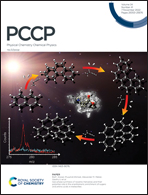Yellow to blue switching of fluorescence by the tuning of the pentaphenylphosphole structure: phosphorus electronic state vs. ring conjugation†
Abstract
The interaction between diphenylacetylene and dichlorophenylphosphine under various conditions is a simple method for the preparation of pentaphenylphosphole derivatives exhibiting fluorescence properties. Depending on the electronic state of the various centers of the phospholic structure, it was possible to obtain molecules with fluorescence, as in the blue area for 1,2,3,4,5-pentaphenyl-2,5-dihydro-phosphole-1-oxide (H2PPPO), in the yellow area for 1,2,3,4,5-pentaphenylphosphole-1-oxide (PPPO) and in the cyan area for 1,2,3,4,5-pentaphenylphosphole (PPP). The effect of the structure and π-conjugation on the optical properties of these compounds was studied using PPP derivatives as examples. Unusual changes in the optical properties of PPP derivatives in solution and in the crystalline state are explained. In the case of agglomeration of PPPO and PPP molecules, the effect of aggregation-induced emission (AIE) was observed to have weak fluorescence in solution and strong fluorescence in the aggregated state. However, for H2PPPO, the AIE effect remains mild. With the help of experimental studies, supported by theoretical calculations, the main mechanism of the optical properties of pentaphenylphosphole derivatives has been revealed. It was observed that the intramolecular motions of PPPO and PPP are more limited in the solid state than the motions of H2PPPO, which is associated with less conjugation of the phenyl rotors of H2PPPO. The analysis of the structure and distribution of electron density showed why hydrogenation of the phosphole ring leads to a sharp change in the optical properties of pentaphenylphosphole derivatives, while the oxidation of phosphorus does not lead to the disappearance of the AIE effect and to a lesser extent affects the change in the fluorescence wavelength. Thus, it was shown how the regulation of various structural features of the phospholic ring helps to control the optical properties of such compounds.



 Please wait while we load your content...
Please wait while we load your content...